Mazda’s CX-30 has a couple of things going for it that most of its competitors either charge extra for – or don’t offer at all.
The CX-30 also hasn’t got two things that are getting hard to avoid in a new crossover.
What It Is
The CX-30 is Mazda’s compact-sized, lowest-priced crossover. It differs from other small crossovers in that it comes standard with AWD – and a six speed automatic (rather than a CVT automatic, a dual-clutch automatic or an automatic with eight or more forward speeds).
It also does not come standard with an undersized engine, turbo-boosted to make up for it. But if you want the most powerful turbocharged engine available in the class – and for the money – it’s available, too.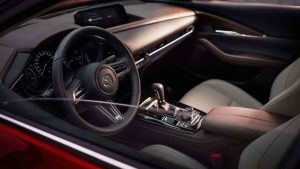
Prices start at $24,995 for the base 2.5 S trim which – as the name suggests – comes standard with a 2.5 liter four cylinder engine (without a turbo, because it doesn’t need one), standard AWD and a six speed automatic transmission.
If you’d like a turbo to to go with that, the new $32,790 2.5 Carbon Turbo has that – plus a larger (10.25 inch) LCD display, Zircon sand-metallic exterior paint and Terracotta synthetic leather upholstery.
A top-of-the-line 2.5 Turbo Premium Plus stickers for $36,800. It comes with the turbocharged engine, plus adaptive cruise control, a heated steering wheel, a 12 speaker premium Bose audio system, a Heads Up Display (HUD) and navigation added to the infotainment system.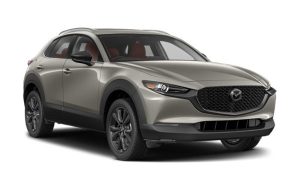
What’s New for 2024
The Carbon Turbo trim is new – and enables buyers who want the more powerful turbocharged version of the 2.5 liter engine to get it for less than it cost to buy last year – when buyers who wanted it had to buy the $33,800-to-start Turbo Premium.
On the downside, the base 2.5 S CX-30’s price is up vs. last year, when you could buy that one for $22,950.
What’s Good
Standard engine is big enough – and strong enough – to not need a turbo to make up for being too small (and weak).
AWD is standard; it’s optional in rivals such as the VW Taos (which also costs several thousand dollars more than the CX-30 when ordered with AWD).
Analog controls – knobs and switches – can be used to adjust the temperature/fan speed and volume by feel without having to take your eyes off the road.
What’s Not So Good
Even though it cost about $1,000 less than it did last year, the optional turbo engine is still a very expensive option – adding almost $8k to the 2024 CX-30’s MSRP.
Rotary mouse control for the audio system requires multiple steps to access the source you want (such as FM or satellite) and then another step to select the channel you want.
No square-style (old school) USB charger outlets.
The CX30 is unusual in that its standard 2.5 liter engine is big enough to be strong enough by itself – and so doesn’t need a turbo to make it strong enough. It’s common for small crossovers in this class to have standard engines 2.0 liters or less in size. The VW Taos, for instance, comes standard with a 1.5 liter engine – and so it needs a turbo to make up for the size it’s lacking. More finely, to make up for the power that would otherwise be lacking. Even with a turbo, the VW’s motorcycle-sized engine only manages to make 158 horsepower.
The Mazda’s 2.5 liter engine makes 191 horsepower.
Turbocharging it is not necessary for it to have enough power to get the CX-30 to 60 MPH in about 8 seconds, which may not be “quick” but also isn’t slow. Interestingly, the smaller-engined Taos takes about as long to get to 60 and it uses more gas – 24 city, 32 highway when paired with the extra-cost AWD system.
The Mazda – with standard AWD – rates 26 city, 33 highway.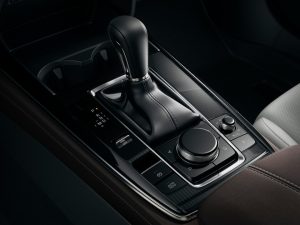
Hyundai’s Kona is another under-engined rival. It comes standard with a 2.0 liter four that makes 147 horsepower and takes about the same 8 seconds to get to 60 while getting worse gas mileage (27 city, 29 highway) when ordered with the optional AWD system that increases the Kona’s price to $25,750 – which is just shy of $800 higher than the price of the bigger-engined, more economical CX-30 with standard AWD.
Another thing worth a mention in the Mazda’s favor is that its standard automatic transmission is a six speed automatic. The VW Taos comes standard with an eight speed automatic and the Kona comes standard with a CVT automatic.
Why is that worth mentioning?
Well, a six speed automatic is a simpler and for that reason inherently more reliable type of automatic than an automatic with eight (or more) speeds). The more a transmission shifts, the more action there is. The odds of eventual problems with all that shifting increase, too. And a transmission with speeds rather than ranges (as in a CVT) is also likely to last longer.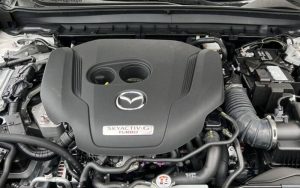
If you want a turbocharged engine, Mazda offers that, too. The boosted version of the 2.5 liter engine makes a class-highest 250 horsepower.
The VW Taos offers no optional engine and the Hyundai Kona’s optional 1.6 liter turbocharged engine maxes out at 190 horsepower – 1 less horsepower than comes standard in the Mazda without the turbocharged version of the 2.5 liter engine.
Equipped with the 250 hp engine, a CX-30 can get to 60 in the mid-high five second range, which is quick. The only catch is that this engine only makes its maximum advertised power if you fill the tank with premium unleaded. If you use regular unleaded, the computer that controls the boost will dial the latter down a bit such that the engine only makes 227 horsepower. But that’s still more than you can get in a Taos or a Kona – irrespective of the fuel you feed them.
Mazda has become a lot like what BMW was, once – but isn’t as much anymore. There was a time when BMW appealed to people who appreciated a sophisticated driver’s car. Very few new cars appeal to drivers anymore. Including most new BMWs. They are nice cars, of course.
But that’s not quite the same thing.
Mazdas are a different thing; more like the kinds of cars BMW used to make. This includes even crossovers like this CX-30, which try hard to come across to the driver more like a Miata than a crossover. And that makes this crossover appealing to drivers who’d love to have a Miata – but for one reason or another have to have more room for passengers and cargo than are available in a Miata.
Forget what’s behind you and you can enjoy a drive in a five-door crossover that doesn’t feel like driving one. Remember: The same engineers who fine-tuned the Miata’s steering and suspension also worked on the CX-30’s handling characteristics with the intention of making it feel like a Mazda. That is to say, something that isn’t just-another-crossover.
They succeeded.
From behind the wheel, you look out over a sports car-like long hood and in front of you are sports car-like analog gauges housed in a sports car-like gauge cluster.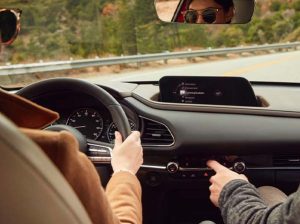
With – or without – the turbo, the 2.5 liter engine has gusto that’s lacking in rivals’ engines, which were designed chiefly to be compliance engines. That is to say, with “efficiency” being the prime consideration (even though they end up being not all that “efficient”). The same as regards the Mazda’s six speed automatic. Eight (and more) speed automatics – and CVT automatics – are compliance transmissions. They are designed chiefly to eke out an extra MPG or two – at the cost of responsiveness and almost certainly long-term reliability.
When you push down on the accelerator, the Mazda’s transmission doesn’t need to shift down two (or even three) gears before the thing accelerates – because it is already closer to being in the right gear for acceleration. Shift-action is nicely snappy when you floor it but also when you’re not flooring it.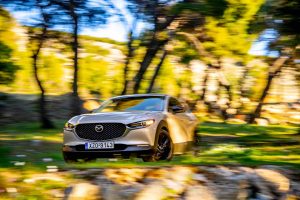
Compliance transmissions are often programmed to upshift as quickly as possible to the highest-possible gear, so as to reduce engine RPM as quickly as possible – even if the cost of doing that is a sluggish-feeling vehicle that almost forces you to floor the accelerator pedal to get it to accelerate.
If only Mazda offered this spunky little crossover with a manual transmission. Then it would be nothing like anybody else’s crossover – and more than just the practical alternative to a Miata.
Practicality is why crossovers have almost completely replaced cars; you can fit more stuff inside the shape – even if it’s the same footprint.
The CX-30 is 173 inches long, which means it has a smaller footprint than a compact-sized sedan such as the the current Honda Civic sedan – which is 184 inches long. But the smaller footprint Mazda has three times as much total cargo carrying capacity – 45.2 cubic feet with its second row folded down vs. 14.8 cubic feet in the Civic’s trunk. Both vehicles have about the same front and rear seat legroom for passengers, too – even though the Civic is almost a foot longer.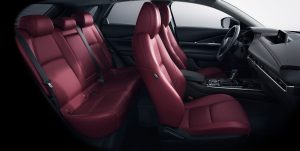
And the Civic – which was once an economy car – isn’t cheap anymore, either.
Its base price – $23,950 – is almost exactly the same as Mazda asks for the much more practical CX-30, which has enough room for both people and stuff to be a viable family vehicle. A small sedan like the Civic is still a fine commuter/single person’s car. But its price is harder to pay when you could buy something like the CX-30 with more room – and standard AWD – for about the same money.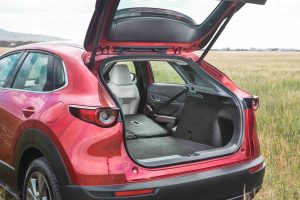
But the main thing selling this crossover isn’t that – because other small crossovers like the Taos and Kona are also practical. It is that this crossover looks more like something that isn’t another crossover. You can tell it’s a Mazda, first of all – and that’s not a small difference vs. the wearying sameness of practically everything else. Just like you used to be able to tell a BMW from all the others.
One of the specific things Mazda does to make the CX-30 look unliked the others is to make it look more like a rear-drive sport sedan by giving it a proportionately long front end, as if it needed the space up there to house an engine mounted front-to-back rather than side-to-side.
It’s a very attractive look, complemented by the absence of the gut-hooked catfish face (or angry robot face) that afflicts so many new vehicles, generally. In sum, a practical, good-looking little crossover that costs less than others in its class and about the same as you’d pay to get into a current compact-sized sedan.
Two small things detract from this otherwise appealing alternative to the rest. The first is the rotary mouse controller on the center console. You use this to control the audio system and to access the other menu items displayed on the 8.8 inch LCD display that sits atop the center stack, to the driver’s right. It’s a two-step process. First, you rotate the knob until what you want is highlighted in the display. Then you push down to access that. So, to change the audio source, you rotate the knob until it’s highlighted, then select by pushing the mouse. Then you have to tune to the station you want, by highlighting the “tune” options – and then you can rotate the knob to change the station.
A one-step process – such as having a “tune” knob to change the channel – would be easier. But Mazda, like every other manufacturer, is moving away from individual knob/button controls to single control interfaces, chiefly because its cheaper to build vehicles that way and also because it cleans up the interior – which would otherwise have a bunch of buttons, switches and toggles to control all of the functions and features that new vehicles come with.
But you get used to using the mouse thing after awhile and once you do, it’s not a big deal.
The other thing is a smaller thing.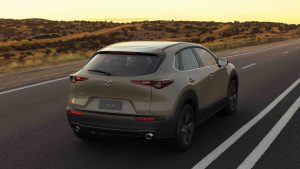
This Mazda, like most new vehicles, only has the “new” USB charge ports. The rounded ones rather than the old-style rectangular ones. It’s not a big deal – because you can use adaptors, if you have a phone or other device that uses the old-style hook-ups. But it is an inconvenience – if you don’t happen to have an adaptor.
The Bottom Line
Crossovers are – for the most part – like detergent. They’re useful, but hard to get excited about. Here’s one that’s might make you want to do the wash, for once.
. . .
If you like what you’ve found here please consider supporting EPautos.
We depend on you to keep the wheels turning!
Our donate button is here.
If you prefer not to use PayPal, our mailing address is:
EPautos
721 Hummingbird Lane SE
Copper Hill, VA 24079
PS: Get an EPautos magnet or sticker or coaster in return for a $20 or more one-time donation or a $10 or more monthly recurring donation. (Please be sure to tell us you want a magnet or sticker or coaster – and also, provide an address, so we know where to mail the thing!)
If you like items like the Baaaaaa! baseball cap pictured below, you can find that and more at the EPautos store!





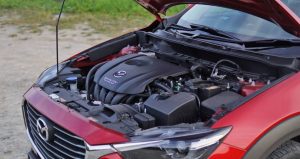
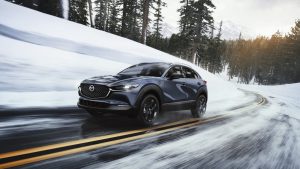
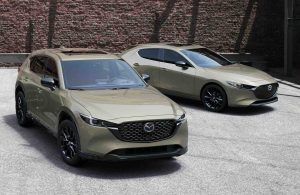
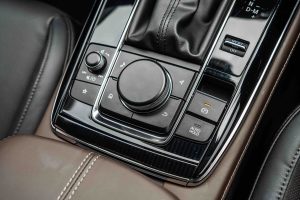
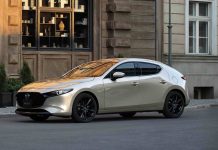






I purchased a new ‘23 Mazda 3 last November, with the basic trim level. It has so far been the best car I have ever owned ( I am a “seasoned” citizen as the late Rush used to say) and have owned many cars and pickups throughout my lifetime.The two best vehicles I have ever owned were: were late ‘70s and ‘80,s F250 with International 6.9 and 7.3 diesels and all had manual gearboxes. This was before the EPA added stupid emissions controls on them. These now old school engines were basically school bus engines back in their day. These were bullet proof, and there are still a few around-those which are not rusted out or simply worn out. My next favorite vehicle is the Mazda. All that Eric mentions is true, except he missed a very important point: Mazda does not have that asinine start/stop feature, it stays running at a red light-imagine that! When stopped at a red light I often observe other cars around me starting their engines with the struggle and groaning of a worn out starter and flywheel. The Chevys, Jeeps, and Fords often sound like the owner is going to have to get his wallet out soon.
These matters are just my opinion and unscientific observations, but I would not overlook Mazda. As an aside-my brother and sister in law live in a country which has many freedoms we no longer have, Panama. Mazda, Toyota etc. routinely are equipped with manual transmissions and diesel engines. And Toyota has the Hi-Lux small pickup-like we used to have when we were a semi-free nation. Kind of like Eric’s older Nissan Frontier but a late model. My brother has a late model Ford Ranger with a 5 cyl. diesel, he absolutely loves it! Again-Imagine that?
Hi Dr. G!
I’m a fan of Mazda’s as well; and thank you for mentioning what I ought to have about ASS – and Mazdas not having this obnoxious “feature.”
I sold Mazdas in between jobs for about 2 weeks back in 08. I liked the sharp handling and the responsive engines. The 2.5 has been around forever.
Hey Eric, I’m surprised you didn’t comment on the unique exhaust manifold design of the 2.5 Turbo. My mom bought a ’23 CX-30 Turbo Premium and loves it. She’s almost 80 but wants power when she wants it. I know that many here do not like more tech but… She loves the HUD. I often have to walk her through stuff on her phone or PC but she loves the HUD.
Anyways… that exhaust manifold is odd… but designed for a purpose. It’s hard to find info on the operation but… the header is like a 4-3-1 design with… from what I’ve seen… a purely mechanical flap that closes at 1620 rpm to increase flow to the turbo and eliminate lag at lower rpm. That motor is a gem… fwiw.
So… Again, I’m not 100% sure but this seems to allow Mazda to use a cheaper, less complex non-variable-geometry turbo with this less complex and cheaper exhaust manifold. It’s hard to find exact info on this setup and, of course, when I asked the sales staff about it… they knew nothing.
The guy in charge of picking colors for Mazda must own a side business wrapping new Mazdas.
regular automatic with gears is enough for me to recommend this car to people that ask me.
Please keep it going this way Mazda.
Got my wife a ’23 CX-5 PP. Better visibility and noticeably better quality being made in Japan. She complained it didn’t have the scoot that her ’18 Mazda 3 GT had and I told her “well dear, it it 700 pounds heavier than your Mazda 3 with the same engine”. The power to weight ratio is still pretty good with the NA engine.
Harley Davidson is shutting down manufacturing in USA and moving to Thailand.
https://www.rideapart.com/news/729692/harley-thailand-production-pan-america/
$25k, non turbo, and a non CVT. One of the few left.
Unfortunately can’t get away from the over wrought techie nonsense, but a stupid controller is better than a lot that’s out there.
‘First, you rotate the knob until what you want is highlighted in the display. Then you push down to access that. So, to change the audio source, you rotate the knob until it’s highlighted, then select by pushing the mouse. Then you have to tune to the station you want, by highlighting the “tune” options – and then you can rotate the knob to change the station.’ — eric
Anathema. Odious dogshit. Also, unsaaaaafe.
I will not be put through degrading school-pupil exercises by imbecile coders seeking to conform me to their algorithm. This is exactly like having to fill out a form by writing primitive block letters in individual boxes — or darkening printed circles with a pencil (ball point not allowed) on a standardized test to find out whether you’re retarded (or psychotic, or sexually deviant).
Antagonized, I impetuously stamp my foot, demanding the simple, direct mechanical controls which have been available for over a century now, until stiiiiiinking chips took them away, and reduced us to slaves of an imposed, regressive and demeaning technology.
I had a CX-9 and put well over 300K miles on it. Other than the road noise it was a good car.
Sadly, these are all made in Mexico, so I’ll have to say they’re a hard no.
It’s been a year or three, but Mazda has a red paint that is just gorgeous. It looks 3 feet deep and glows deep red. My eye is drawn to it every time I see one.
The first car I drove was a Mazda RX3. Ok, I never got out of 1st gear and as a kid I already knew driving was something I had to take very seriously, but it hooked me on stick shifts to this day. So sad the rotary became a specialty engine instead of common, but the EPA destroys everything.
One of my neighbors has the red one and I totally agree – it’s amazing in the sun. And I do think the Mazda design is superior to most of the others.
I’ve had a couple Mazdas (RX-7 and Mazda 3) and I’m a fan. They tried to solve the EPA thing with the RX-8 but it had some challenges.
I have that silly console based control thing in the Audi. It works fine once you get used to it, but my dog steps on the buttons all the time. It makes me wonder if the people who engineer the cars ever actually drive them. Back in the day Volvo relocated the window switches to the center console direct in front of the armrest – which housed the slide-out cup holders. Spilled beverages and window switches don’t belong together.
@Eric – Does the CX-30 still have the 12V “cigarette lighter” adapter?
I’d much rather have one of those than either form of USB port.
With a 12V outlet, there isn’t a chance that the port will make your phone go “Full Locutus”.
Even with our 2016 Jetta, I have to use a USB port filter to avoid connecting my phone into the hive mind.
Something to think about — I don’t think I’ve seen a commonly available filter for the new round USB-C ports.
Hi Roscoe,
Yes, it does! I appreciate your asking about that. I ought to have mentioned that in the review.
Mazda hasn’t been fully assimilated … yet.
BTW, my wife’s nephew, previous owner of the Jetta, never bothered to look at why the 12 V outlet didn’t work when he bought the car used.
Simple fuse.
He also had the factory air filter at 60,000 miles. Yes, a Torx screwdriver is involved in the replacement job, but that still isn’t a good excuse.